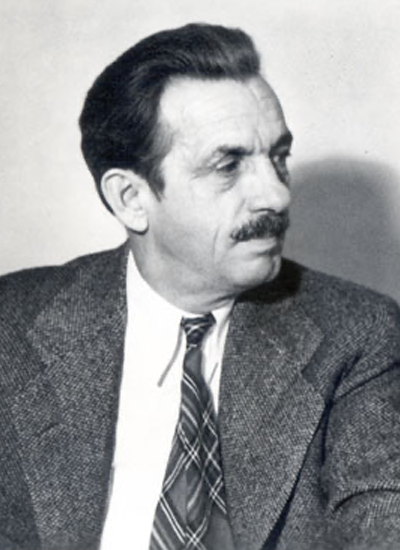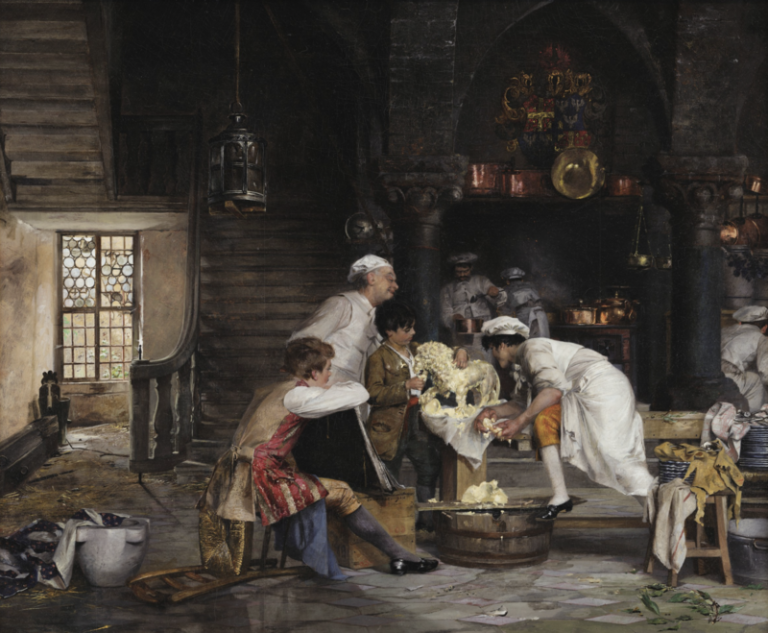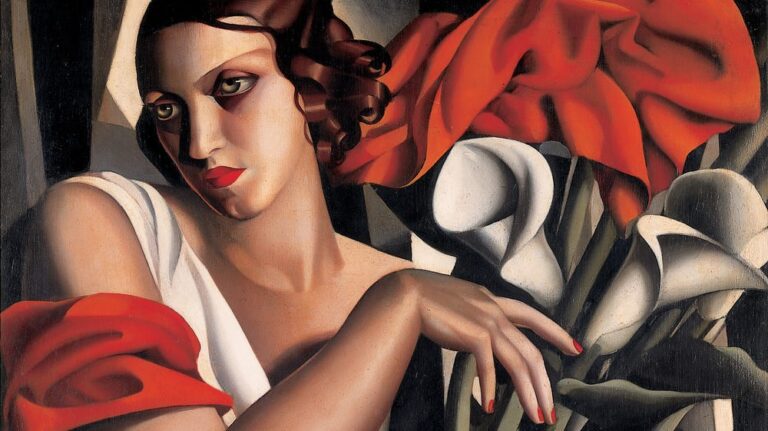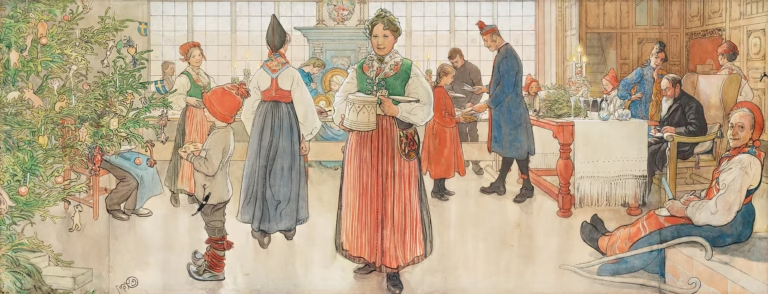Thomas Hart Benton Painter: America’s Influential Regionalist Artist
Born: April 15, 1889, Missouri, United States
Death: January 19, 1975, Martha’s Vineyard, United States
Art Movement: Regionalism, Realism, Modernism, Synchromism
Nationality: American
Influenced By: Jackson Pollock, James Lesesne Wells, Lewis Hine
Institution: The School of The Art Institute of Chicago and Académie Julian
Thomas Hart Benton Painter: America’s Influential Regionalist Artist
Life and Education
Thomas Hart Benton’s journey from his Missouri roots to becoming a defining American artist spanned decades of learning and personal development. His background, training, and mentors all played crucial roles in shaping his distinctive artistic style.
Early Years and Family Background
Thomas Hart Benton was born on April 15, 1889, in Neosho, Missouri, into a politically prominent family. His father, Maecenas Benton, served as a U.S. congressman, while his great-uncle was the famous Senator Thomas Hart Benton, after whom he was named.

The Sources of Country Music, 1975 by Thomas Hart Benton
Growing up in a small Midwestern town, young Benton showed artistic talent from an early age. His mother encouraged his creative pursuits, though his father hoped he would follow the family tradition into politics or law.
At age 17, Benton began working as a cartoonist for the Joplin American newspaper. There, he developed skills in observation and visual storytelling that would later influence his artistic style.
Formal Art Training
Benton’s formal education began at the Art Institute of Chicago in 1907, where he studied for two years. His training continued at the Académie Julian in Paris from 1908 to 1911, exposing him to European modernist movements.
In Paris, he experimented with various styles, including Impressionism and Synchromism, before finding his distinctive approach. These early explorations helped him develop technical skills while searching for his authentic voice.
After returning to America, Benton briefly taught at the Art Students League in New York. This experience solidified his understanding of artistic principles and helped him articulate his emerging theories about American art.
Influential Teachers and Mentors
Several key figures shaped Benton’s artistic development. In Paris, he studied under Jean-Paul Laurens, a respected academic painter who emphasized strong draftsmanship and composition.
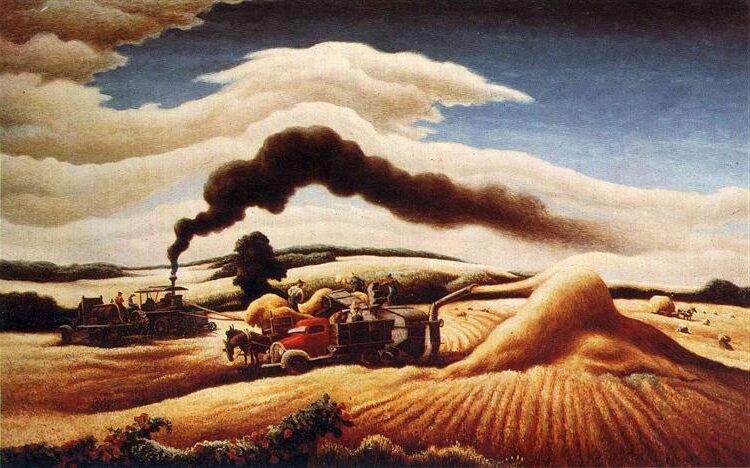
Threshing Wheat, 1939 by Thomas Hart Benton
Stanton Macdonald-Wright, co-founder of Synchromism, became a significant influence during Benton’s formative years. Their friendship exposed Benton to color theories that would inform his later work, though he eventually rejected abstract approaches.
Benton’s most important mentor was arguably the American cultural landscape itself. His travels throughout rural America during the 1920s and 1930s connected him with ordinary people and regional traditions. These experiences profoundly influenced his artistic vision and commitment to depicting authentic American life.
Artistic Style and Contributions
Thomas Hart Benton developed a distinctive American artistic voice that captured everyday life and historical narratives. His vibrant, flowing style combined elements of Modernism with realistic portrayal of American scenes and people.
Development of Regionalist Style
Benton’s artistic journey began with formal training in Paris, where he studied modern European techniques. However, he rejected European abstraction in the 1920s to develop his uniquely American style. This shift marked the beginning of the Regionalist movement, which celebrated American rural and small-town life.
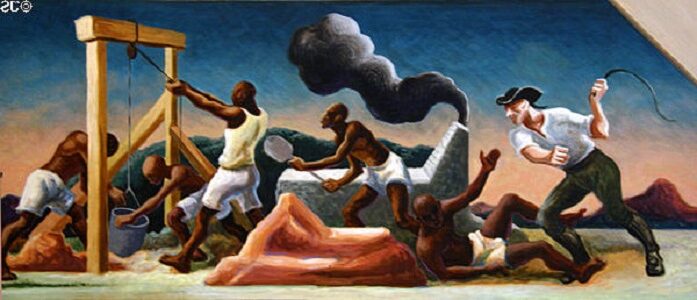
A Social History of the State of Missouri (detail) – Slaves Used for Lead Mining, 1936
Benton traveled extensively throughout America’s heartland, filling sketchbooks with observations of ordinary people at work and play. These journeys deeply influenced his artistic vision.
His style featured curving, undulating forms that gave his paintings a sense of movement and energy. Benton often portrayed American folk culture with a documentary-like approach while maintaining a distinctive stylized quality.
Notable Works and Murals
Benton’s most significant contributions came through his large-scale murals depicting American history and life. His “America Today” mural (1930-31) portrayed a vibrant cross-section of American society during the Machine Age.
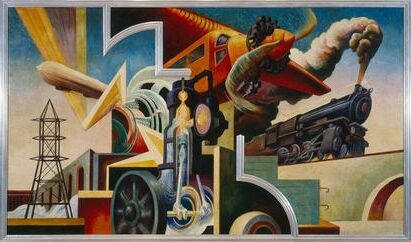
America Today, 1930-1931 by Thomas Hart Benton
The Missouri State Capitol murals (1936) stand among his most celebrated works. These panels chronicle Missouri’s history from settlement to industrialization with remarkable detail and narrative power.
Other notable murals include:
- “Arts of Life in America” (1932)
- “Indiana Murals” (1933)
- “Social History of Missouri” (1936)
His easel paintings like “Cradling Wheat” (1938) and “July Hay” (1943) captured rural American life with the same dynamic energy as his murals.
Technique and Medium
Benton developed a unique painting technique that combined elements of classical training with innovative approaches. He typically began with small clay models to work out compositional problems before starting a painting.
His distinctive method involved applying thin, transparent layers of egg tempera over a base of oil paint. This technique created luminous effects and rich textures that became hallmarks of his work.
Benton used strong, sinuous outlines and bold colors to create rhythmic compositions. His figures often featured exaggerated, muscular forms that emphasized physical labor and movement.
He maintained meticulous attention to detail while employing distorted perspectives and dramatic angles. These choices gave his work a cinematic quality that drew viewers into his narrative scenes.
Legacy and Impact
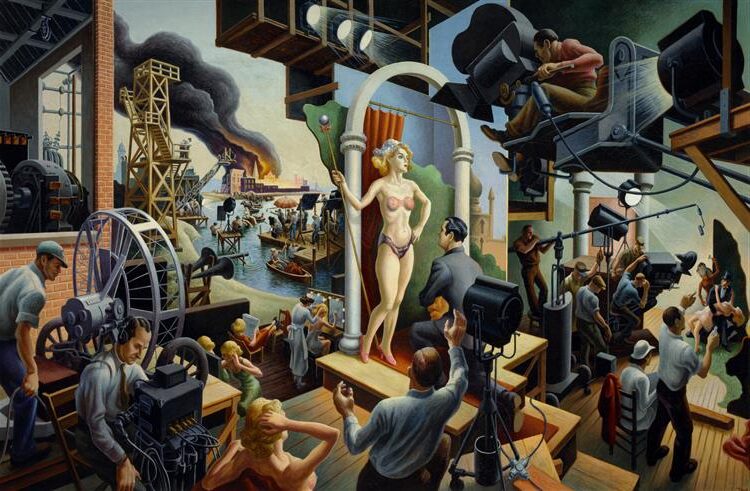
Hollywood, 1937–1938 by Thomas Hart Benton
Thomas Hart Benton’s distinctive style and dedication to capturing American life established him as one of the most significant American artists of the 20th century. His work continues to influence artists and captivate audiences today.
Influence on American Art
Benton helped establish Regionalism as a dominant American art movement in the 1930s, celebrating rural and small-town America when many artists looked to Europe for inspiration. His technical innovations, particularly his fluid, sculptural figures and rhythmic compositions, created a uniquely American visual language.
Many notable artists studied under Benton, including Jackson Pollock, who later pioneered Abstract Expressionism. Though Pollock’s mature style differed dramatically from Benton’s, he credited his teacher with instilling strong compositional principles.
Benton’s murals depicting ordinary Americans at work expanded public art’s accessibility. His emphasis on narrative storytelling and social commentary influenced later generations of artists who addressed American identity and social issues.
Exhibitions and Collections
Benton’s works appear in America’s most prestigious museums, including the Metropolitan Museum of Art, Whitney Museum of American Art, and Museum of Modern Art in New York. The Nelson-Atkins Museum in Kansas City houses a significant collection of his paintings and drawings.
The State Historical Society of Missouri maintains the Thomas Hart Benton Home and Studio as a historic site. Visitors can see his studio preserved as it was at the time of his death in 1975.
Major retrospectives of Benton’s work continue to draw large audiences. The 2015 exhibition “American Epics: Thomas Hart Benton and Hollywood” traveled to multiple museums, highlighting his connection to film and popular culture.
Posthumous Recognition
After his death, Benton’s reputation experienced renewed appreciation following a period when abstract art dominated critical attention. Art historians now recognize his crucial role in developing a distinctly American artistic identity.
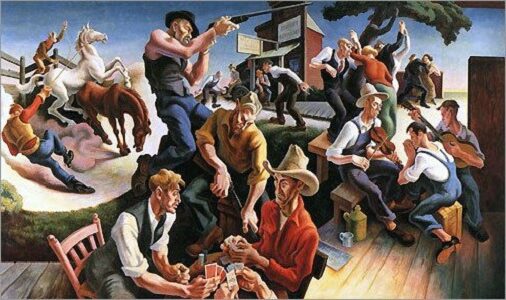
Arts of the West, 1932 by Thomas Hart Benton
In 1989, Benton was inducted into the Hall of Famous Missourians, honoring his contributions to the state’s cultural heritage. His hometown of Neosho, Missouri celebrates his legacy with historical markers and cultural events.
Benton’s paintings command high prices at auction. His 1934 work “The Hailstorm” sold for $4.9 million in 2015, demonstrating his enduring market value.
Several books and documentaries explore Benton’s life and work, including the 2015 PBS film “Thomas Hart Benton” and Justin Wolff’s biography “Thomas Hart Benton: A Life.”
Frequently Asked Questions
Thomas Hart Benton’s artistic legacy includes notable paintings, contributions to Regionalism, and influential murals that captured American life in the early 20th century. His distinctive style and dedication to portraying everyday Americans cemented his place in art history.
What are the most famous artworks created by Thomas Hart Benton?
Benton’s “America Today” mural series stands as one of his most recognized works. Created between 1930 and 1931, these panels depict American life during that era with remarkable detail.
“Persephone,” painted in 1939, shows his mastery of the female form with a distinctive curvilinear style. The work caused controversy for its frank portrayal of nudity.
“The Sources of Country Music” (1975) was Benton’s final masterpiece, completed shortly before his death. This mural captures the varied influences that shaped American country music.
“Achelous and Hercules” (1947) demonstrates Benton’s ability to blend mythology with American regional themes. The painting features his characteristic muscular figures and dynamic composition.
How did Thomas Hart Benton contribute to the Regionalist art movement?
Benton helped establish Regionalism as a major American art movement in the 1920s and 1930s. He rejected European modernist trends, instead focusing on scenes of rural and working-class American life.
His paintings celebrated ordinary Americans, particularly those in the Midwest and South. This approach provided a visual counterpoint to urban-centered art movements of the time.
Benton’s teaching at the Art Students League in New York spread Regionalist ideas to younger artists. His technical approach to composition influenced many students who later developed their own styles.
His writings, particularly his autobiography “An Artist in America” (1937), articulated the philosophical foundations of Regionalism. These texts helped define American art during the Depression era.
What influence did Thomas Hart Benton have on other artists of his time?
Jackson Pollock studied under Benton at the Art Students League. While Pollock later rejected Benton’s style for abstract expressionism, he credited Benton’s teachings about rhythm and composition.
Benton’s emphasis on American subjects encouraged many artists to look to local landscapes and people for inspiration. This approach helped establish a distinctly American artistic identity.
His technical skills in composition and movement influenced both traditional and avant-garde artists. Many appreciated his mastery even when pursuing different artistic directions.
Benton’s public murals demonstrated how art could reach broader audiences outside elite galleries. This democratic approach inspired other artists to consider public art projects.
Can you describe the main characteristics and themes present in Thomas Hart Benton’s paintings?
Benton’s work features exaggerated, flowing forms with muscular figures that create a sense of movement. These curvilinear elements give his paintings a distinctive visual rhythm.
Rural American life appears prominently in his work, including farmers, laborers, and everyday scenes. He often depicted people engaged in physical work, emphasizing their strength and dignity.
His color palette typically includes rich earth tones contrasted with vibrant accents. This approach creates dramatic scenes that draw the viewer’s eye across the composition.
Musical themes appear regularly in Benton’s work, reflecting his love of folk music. He frequently painted musicians, dancers, and social gatherings where music played a central role.
What role did Thomas Hart Benton play in the development of American murals during the 20th century?
Benton revitalized American mural painting through his large-scale public works in the 1930s. His projects for the New School for Social Research and the Missouri State Capitol demonstrated art’s civic potential.
His narrative approach told American stories through interconnected scenes. This storytelling technique made complex historical and social themes accessible to general audiences.
Benton’s murals often addressed controversial social issues including race, labor, and industrialization. These works sparked public discussions about American identity during a time of national crisis.
His technical innovations in mural composition influenced government-sponsored art programs. During the Depression, the Works Progress Administration (WPA) employed artists who followed Benton’s example.
How did Thomas Hart Benton’s early life and education shape his artistic style?
Benton’s childhood in Missouri exposed him to rural American life and culture. These early experiences provided subject matter that would later define his work.
His formal training included studies in Chicago and Paris. In Paris, he encountered modern art movements. Though he later rejected European styles, this education gave him technical foundations.
Working as a Navy draftsman during World War I taught Benton precision in rendering objects and scenes. This experience influenced his meticulous approach to composition and form.
His political background, coming from a family of politicians, informed his interest in American social issues. Benton’s grandfather was a prominent U.S. Senator, giving him awareness of public discourse that later appeared in his art.


